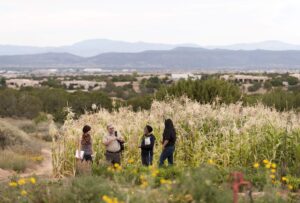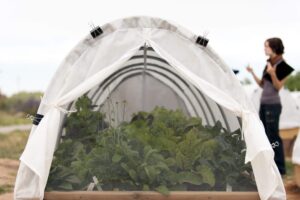By Triana Reid
Teresa Quintana opens the middle drawer of a dark green file cabinet and gently picks up various mason jars, paper sacks, and plastic baggies. Quintana (Kiowa), the program associate and gardener with the Institute of American Indian Arts’ (IAIA) Land-Grant Program, says their names, reading labels on the containers or peering inside to identify the seeds: black beans, Cherokee beans, pinto, Zuni gold, sun cherries, pumpkin, blue corn, amaranth, ground cherries, posole, and a jar of mystery chiles.

Quintana says that the seeds have been saved and grown in IAIA’s Turtle Garden since 2010.
She opens another drawer of medicinal flower seeds: nasturtium, marigolds, echinacea, cota, and cosmos. Finally, Quintana lifts a huge dried sunflower head out of a basket. Its bone-dry, petalless head encases hundreds of seeds. “[These foods] are our ancestors just like people are. They’ve been on this earth since the beginning of time,” Quintana says.
Quintana adds that together these plants create an ecosystem in which unwanted bugs are naturally deterred without the use of chemical pesticides, and pollinators are attracted to the garden. Over the course of 2021, Melanie Kirby (Tigua/Apache), the Land-Grant extension educator, will be introducing honeybee hives to campus to promote and pollinate the existing ecosystem. If successful, those bees will not only nourish IAIA’s seed collection but contribute to its future as a viable seed bank.
Kirby, who has been a professional beekeeper for 24 years, speaks lovingly about her honeybee farm and queen-rearing operation up in Vadito, New Mexico, along the high road to Taos. “[Bees] are akin to other types of livestock,” Kirby says. “And when I say livestock, I don’t mean just like a head of cattle or a number. I mean that they are alive and that they have value.” She considers herself a seed saver too, but in her case, bees are the seeds.
The Land-Grant Program will be strategic in its plans for honeybee introduction. Kirby will be working with Fish and Wildlife Services to map the area and find the best locations for the hives and for planting native plants and flowers to ensure that all pollinators on campus will have enough forage to sustain healthy lives. “We live in a pretty tough climate in New Mexico,” Kirby says. “There is plenty of bloom, but there’s also strange weather.” The latter means that plantings will need to be placed near water sources in order to thrive through months of drought and harsh winters.
Kirby says, “All of us humans here have expanded. What can we do to really work in tandem with our environment and to be respectful of our space and our place and our obligation to take care of it?”

Kirby speaks in terms of the climate crisis: “There’s a fraction of us who think that we can control Mother Nature, and there’s a fraction of us—I’m more in this other school of thought—which is, ‘No, we can’t control nature. We are a part of nature.’”
Kirby worries that this second school of thought ignores the importance of interconnectedness and that some organisms may not be able to adapt in time. Her idea of interconnectedness extends to the functionality of biomimicry, which, as explained by the Biomimicry Institute, “is a practice that learns from and mimics the strategies found in nature to solve human design challenges.” Biomimicry will be a key design model for introducing honeybees to the IAIA campus in a way that mimics the existing biological ecosystems. As climate change influences weather patterns across the globe, Kirby says, biomimicry will be key for human societies adapting into an unknown future. Thinking about the ultimate stakes of biomimicry and agriculture in today’s quickly changing environments, Kirby says: “That sort of fear of the unknown, I feel, is a call to action to folks. You’re going to have to choose. And it’s not that the choice is, well, ‘Let’s go back in time.’ We can’t go back in time. So my hope is that there will be more efforts for biomimicry.”

The long-term goal of both the Land-Grant Program’s honeybee hives and gardens is to nourish the IAIA community. Kirby plans to make the honey—a medicine and natural sweetener—available to students, staff, and faculty. Kirby also hopes that the hives will act as teaching apiaries for the IAIA community.
Quintana created the seed collection and the Turtle Garden to foster and nourish the community. The produce from the greenhouse and outdoor gardens is shared first with the café, then the food pantry, and then offered to the staff and faculty. Although it is not yet a full seed-lending library, Quintana says that if people reach out wanting to start a Three Sisters garden, she and the others in the Land-Grant office are more than happy to pass on the seeds. They hope that anyone starting a Three Sisters garden will save the seeds and be able to plant for years to come.
“The Creator gave these foods to us because that’s what we need,” Quintana says. “We are seeds even, especially women. We’re born with our seeds. Our grandmothers were born with us, and it goes that far, every generation—that’s how we are connected.”

Triana Reid is from Taos, New Mexico and will be graduating from the Institute of American Indian Arts with a BFA in poetry this coming fall.